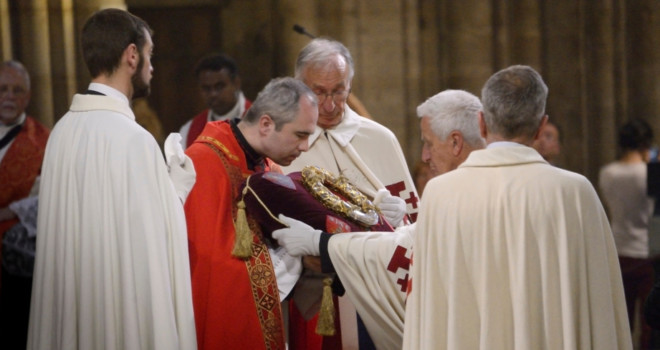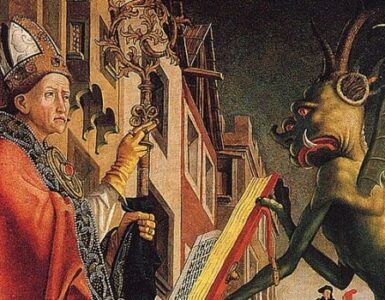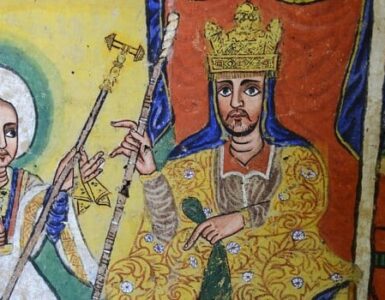Except in the Bible, the Crown of Thorns is not mentioned by any writer during the first four hundred years. It is supposed to have been hidden, but St. Paulinus, bishop of Nola (409-431), speaks of its existence as a well-known fact. St. Gregory of Tours is, however, the first to speak explicitly of it.
About the year 800, the patriarch of Jerusalem sent to Charlemagne a Nail, a piece of the Cross, and some of the Thorns from the Crown. These relics were given to the Abbey of St. Denis by Charles the Bald (823-877); an inscription on his tomb recorded this donation.
At the time of the First Crusade, Alexius Commenus (c. 1050-1118) wrote to Count Robert of Flanders, describing the many precious relics that were in the city of Constantinople, to persuade the Latins to consider the defense of that place incumbent on them as containing memorials of our Lord’s Passion.
This was cunningly urged at the time when Western Christendom was burning to rescue holy places. Among these relics, he mentioned the column to which Christ was bound for flagellation, the lash with which He was scourged, the purple robe, the Crown of Thorns, the reed, mockingly placed in His hand for a scepter, a piece of the Cross, some of the Nails, and the linen cloths found in the Sepulcher on that first Easter.
Removed from Constantinople
After the advent of the Latin rulers over the Byzantine Empire, the condition of that state was not enviable. Baldwin II (1217-1273), expelled from the throne of Constantinople, wandered through the European courts to solicit aid for the recovery of his dominions. The pope, Gregory IX (1145-1241), was naturally disposed to espouse his cause; and the Byzantine Crusade was preached in the Papal States with greater earnestness than that which at the same time was arming for the rescue of Palestine.
Louis IX of France (1214-1270) granted to the mendicant emperor large confiscations from the Jews. Baldwin had also borrowed from the Venetians a sum of money on the security of the Crown of Thorns. But his necessities demanded a yet larger supply, which, in order to gain, he had to abandon altogether the treasure. He addressed a letter to Louis of France, asking his “dear cousin and benefactor” to pay the loan thus contracted and to supply him with further funds in exchange for the holy relic.
Louis, by the advice of his ministers, undertook to redeem from Nicolo Quirini and other Venetian and Genoese merchants, to whom it had been pledged, that most precious relic of the Eastern capital: the Crown of Thorns.
Negotiations
On payment to the Italians and to Baldwin himself, the bargain was closed. There were, however, certain difficulties to be overcome.
The Abbey of St. Denis already boasted one Crown of Thorns, the genuineness of which had been proved by miracles. Some people thought this obstacle by no means insuperable, while others of the present day consider that it condemns the verity of both relics. But a morsel of a true relic inserted into a model of the whole always assumed the full title, and doubtless the Crown already possessed by the Abbey of St. Denis consisted of those thorns given to the abbey by Charles the Bald.
Another obstacle was the conscientious scruples of Louis against the commission of simony, a sin that included the bartering of relics, yet which received the countenance of many of the highest ecclesiastics. Baldwin, however, evaded this by making over the Crown of Thorns to the French king “freely and gratuitously” and by receiving equally gratuitously a free gift of money sufficient to meet his wants.
From Venice to France
After the adjustment of these preliminaries, two Dominican monks, James and Andrew, were sent to Venice. One of these brethren had been in Constantinople, where he had frequently seen this Crown of Thorns and was well informed in all concerning Baldwin. They were accompanied by an official with letters charging the keepers to deliver the relic.
Before redeeming the relic, they took all precautions to confirm its authenticity. The seals were carefully examined and found intact, and they affixed their own seals in addition.
Vincent of Beauvais and other historians relate in detail the events of the journey. After a successful voyage, which at this time of the year, Gosselin remarks, was a serious undertaking, having embarked near Christmastide, they arrived in France, and traveled to Villeneuve l’Archevêque, five leagues from Sens.
Here they were met on August 10, 1239, by St. Louis IX, accompanied by his queen-mother, his brothers, many prelates, and nobles of the court, who had proceeded thus far from Paris to do honor to the sacred Crown. The king and his second brother, Robert of Artois (1216-1250), barefoot and in their shirts, carried it into the Cathedral of St. Stephen, in Sens.

The wooden case was here opened, and the seals and documents attesting its authenticity examined. The following day the king and his court returned to Paris, where, eight hours later, the solemn reception took place.
The king and his brother again bore it amid a brilliant escort and enthusiastic populace, chanting hymns and litanies, first to Notre Dame, and afterward to the Chapel of St. Nicholas within the precincts of the palace.
Sainte-Chapelle to Notre-Dame
Sometime after this translation, St. Louis received from Baldwin a piece of the Cross and other relics. To provide a fitting shrine for these memorials of the Passion, the king built the Sainte Chapelle on the site of the ancient chapel of the Palais de Justice. It was begun in 1241 and finished in 1248.
Few edifices in Europe have excited more interest, or been visited with a more profound reverence, than this most beautiful structure, which yet remains an example to this matter-of-fact age. The spire of this architectural gem was burned in 1620 but was replaced by another in 1853, quite in harmony with the rest of the building.

The relics in the Sainte Chapelle were kept there until the Revolution. From the foundation until 1656, the keys of the shrine were kept by the king himself or by one of the nobles delegated by him. When Paris was in the hands of the mob, the Crown of Thorns was carried to the Abbey of St. Denis for safety by order of Louis XVI in 1791 but was brought back to Paris in 1793 and deposited in the Hotel des Monnaies; the following year it was placed in the Bibliothèque Nationale and finally taken to the cathedral of Notre Dame by order of the government, on October 26, 1804.
The Crown is a circlet of shrunken reeds bound together, but without a single thorn remaining. The diameter of the interior of the ring is 210 millimeters, and the section is 15 millimeters; the section of each reed is 1 to 1.5 millimeters in diameter. It is mounted in a ring of crystal: the crystal is in six pieces, which are kept in position by three leaves of bronze, gilt.
To understand how this bundle of thornless reeds formed the Crown of Thorns, it is necessary to disassociate the mind from representations of our Lord’s Passion, which the brush or the chisel place constantly before us, and conceive, not a circle of thorns but a veritable crown, or bonnet, which would cover the crown of the head of the divine Victim.

This bundle of reeds, evidently grown in water or marshy ground, is supposed to have formed the fillet to give shape to the diadem of thorns, and to have passed around the forehead, plaited around and above with the pliable branches of the Arabian nabk plant, which has strong and sharp thorns, or the Rhamnus, called “Christ’s Thorn,” thus forming a semicircular bonnet, called by Diez the helmet of the Son of God. Some say that it was taken off at the same time as the vestures, while others, among whom is Origen, support the general idea that it remained on Christ’s head while He hung on the Cross.
Margaret Stokes held a theory that the thorny diadem was placed on the sacred head to create not pain but humiliation — a parody of the radiated crown worn by the Roman emperors when they arrogated to themselves divinity — that it was intended for an instrument of moral rather than of physical suffering, and thus formed part of the mock regalia.
The poem “In Festo Coronae Domini” was written by Cardinal Bonaventura (1221-1274) in honor of the Crown of Thorns and its acquisition by France and was used as a sequence in the Mass of that feast in the Gallican and Sarum Missals.
✠
This article is from a chapter in Relics from the Crucifixion: Where They Went and How They Got There. It is available from Sophia Institute Press.
featured image: damann / Shutterstock.com












